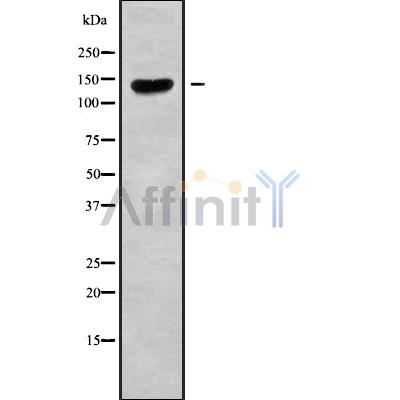CLASP2 Antibody - #DF9398
| Product: | CLASP2 Antibody |
| Catalog: | DF9398 |
| Description: | Rabbit polyclonal antibody to CLASP2 |
| Application: | WB |
| Reactivity: | Human, Monkey |
| Prediction: | Pig, Bovine, Horse, Sheep, Rabbit, Dog |
| Mol.Wt.: | 141kDa; 141kD(Calculated). |
| Uniprot: | O75122 |
| RRID: | AB_2842594 |
Related Downloads
Protocols
Product Info
*The optimal dilutions should be determined by the end user. For optimal experimental results, antibody reuse is not recommended.
*Tips:
WB: For western blot detection of denatured protein samples. IHC: For immunohistochemical detection of paraffin sections (IHC-p) or frozen sections (IHC-f) of tissue samples. IF/ICC: For immunofluorescence detection of cell samples. ELISA(peptide): For ELISA detection of antigenic peptide.
Cite Format: Affinity Biosciences Cat# DF9398, RRID:AB_2842594.
Fold/Unfold
CLAP2_HUMAN; Clasp2; CLIP associated protein 2; CLIP associating protein 2; CLIP-associating protein 2; Cytoplasmic linker associated protein 2; Cytoplasmic linker-associated protein 2; hOrbit2; KIAA0627; Multiple asters (Mast) like homolog 2; Protein Orbit homolog 2;
Immunogens
A synthesized peptide derived from human CLASP2, corresponding to a region within the internal amino acids.
- O75122 CLAP2_HUMAN:
- Protein BLAST With
- NCBI/
- ExPASy/
- Uniprot
MAMGDDKSFDDEESVDGNRPSSAASAFKVPAPKTSGNPANSARKPGSAGGPKVGGASKEGGAGAVDEDDFIKAFTDVPSIQIYSSRELEETLNKIREILSDDKHDWDQRANALKKIRSLLVAGAAQYDCFFQHLRLLDGALKLSAKDLRSQVVREACITVAHLSTVLGNKFDHGAEAIVPTLFNLVPNSAKVMATSGCAAIRFIIRHTHVPRLIPLITSNCTSKSVPVRRRSFEFLDLLLQEWQTHSLERHAAVLVETIKKGIHDADAEARVEARKTYMGLRNHFPGEAETLYNSLEPSYQKSLQTYLKSSGSVASLPQSDRSSSSSQESLNRPFSSKWSTANPSTVAGRVSAGSSKASSLPGSLQRSRSDIDVNAAAGAKAHHAAGQSVRSGRLGAGALNAGSYASLEDTSDKLDGTASEDGRVRAKLSAPLAGMGNAKADSRGRSRTKMVSQSQPGSRSGSPGRVLTTTALSTVSSGVQRVLVNSASAQKRSKIPRSQGCSREASPSRLSVARSSRIPRPSVSQGCSREASRESSRDTSPVRSFQPLASRHHSRSTGALYAPEVYGASGPGYGISQSSRLSSSVSAMRVLNTGSDVEEAVADALKKPARRRYESYGMHSDDDANSDASSACSERSYSSRNGSIPTYMRQTEDVAEVLNRCASSNWSERKEGLLGLQNLLKNQRTLSRVELKRLCEIFTRMFADPHGKRVFSMFLETLVDFIQVHKDDLQDWLFVLLTQLLKKMGADLLGSVQAKVQKALDVTRESFPNDLQFNILMRFTVDQTQTPSLKVKVAILKYIETLAKQMDPGDFINSSETRLAVSRVITWTTEPKSSDVRKAAQSVLISLFELNTPEFTMLLGALPKTFQDGATKLLHNHLRNTGNGTQSSMGSPLTRPTPRSPANWSSPLTSPTNTSQNTLSPSAFDYDTENMNSEDIYSSLRGVTEAIQNFSFRSQEDMNEPLKRDSKKDDGDSMCGGPGMSDPRAGGDATDSSQTALDNKASLLHSMPTHSSPRSRDYNPYNYSDSISPFNKSALKEAMFDDDADQFPDDLSLDHSDLVAELLKELSNHNERVEERKIALYELMKLTQEESFSVWDEHFKTILLLLLETLGDKEPTIRALALKVLREILRHQPARFKNYAELTVMKTLEAHKDPHKEVVRSAEEAASVLATSISPEQCIKVLCPIIQTADYPINLAAIKMQTKVIERVSKETLNLLLPEIMPGLIQGYDNSESSVRKACVFCLVAVHAVIGDELKPHLSQLTGSKMKLLNLYIKRAQTGSGGADPTTDVSGQS
Predictions
Score>80(red) has high confidence and is suggested to be used for WB detection. *The prediction model is mainly based on the alignment of immunogen sequences, the results are for reference only, not as the basis of quality assurance.
High(score>80) Medium(80>score>50) Low(score<50) No confidence
Research Backgrounds
Microtubule plus-end tracking protein that promotes the stabilization of dynamic microtubules. Involved in the nucleation of noncentrosomal microtubules originating from the trans-Golgi network (TGN). Required for the polarization of the cytoplasmic microtubule arrays in migrating cells towards the leading edge of the cell. May act at the cell cortex to enhance the frequency of rescue of depolymerizing microtubules by attaching their plus-ends to cortical platforms composed of ERC1 and PHLDB2. This cortical microtubule stabilizing activity is regulated at least in part by phosphatidylinositol 3-kinase signaling. Also performs a similar stabilizing function at the kinetochore which is essential for the bipolar alignment of chromosomes on the mitotic spindle. Acts as a mediator of ERBB2-dependent stabilization of microtubules at the cell cortex.
Phosphorylated by GSK3B. Phosphorylation reduces MAPRE1 binding. Phosphorylation by GSK3B may negatively regulate binding to microtubule lattices in lamella.
Cytoplasm>Cytoskeleton. Cytoplasm>Cytoskeleton>Microtubule organizing center>Centrosome. Chromosome>Centromere>Kinetochore. Cytoplasm>Cytoskeleton>Spindle. Golgi apparatus. Golgi apparatus>trans-Golgi network. Cell membrane. Cell projection>Ruffle membrane.
Note: Localizes to microtubule plus ends (PubMed:15631994). Localizes to centrosomes, kinetochores and the mitotic spindle from prometaphase. Subsequently localizes to the spindle midzone from anaphase and to the midbody from telophase (PubMed:16866869, PubMed:16914514). In migrating cells localizes to the plus ends of microtubules within the cell body and to the entire microtubule lattice within the lamella. Localizes to the cell cortex and this requires ERC1 and PHLDB2 (PubMed:16824950). The MEMO1-RHOA-DIAPH1 signaling pathway controls localization of the phosphorylated form to the cell membrane.
Brain-specific.
The two SXIP sequence motifs mediate interaction with MAPRE1; this is necessary for targeting to growing microtubule plus ends.
Two TOG regions display structural characteristics similar to HEAT repeat domains and mediate interaction with microtubules.
Belongs to the CLASP family.
Restrictive clause
Affinity Biosciences tests all products strictly. Citations are provided as a resource for additional applications that have not been validated by Affinity Biosciences. Please choose the appropriate format for each application and consult Materials and Methods sections for additional details about the use of any product in these publications.
For Research Use Only.
Not for use in diagnostic or therapeutic procedures. Not for resale. Not for distribution without written consent. Affinity Biosciences will not be held responsible for patent infringement or other violations that may occur with the use of our products. Affinity Biosciences, Affinity Biosciences Logo and all other trademarks are the property of Affinity Biosciences LTD.
